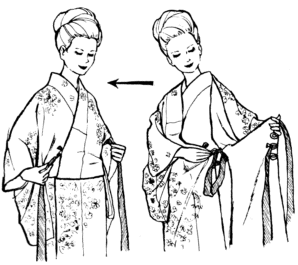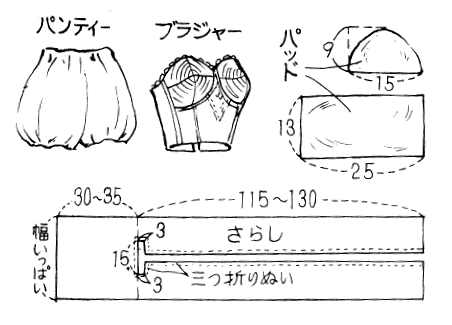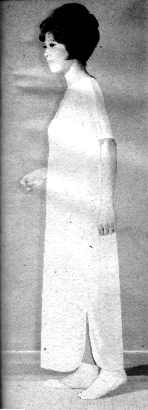By the 1960s, the dual historical blows of Meij modernization and post-war pseudoamericanization had already sealed the kimono scene's doom, but it wasn't going out quietly. For example, the mook these images are from, Wafuku to yosooi ("Japanese clothing and dress"), includes recommended kimono styles for everything from weddings (sure) to travel (why not?) to PTA meetings (your child would refuse to attend school ever again if you tried that today). On the other hand, with hindsight, you can see how a lot of the innovations it showcases were really desperate, last-minute bids for modern relevance.

For example, this kufū ("contrivance") kimono, which uses loops and cords to ensure that even those unpracticed in the art of wrapping cloth artfully around their torsos can attend PTA meetings without worrying about the dreaded kikuzure, a delightful word describing the coming loose and slippage of one's clothing, making you look anything from "sloppy" to "like a salacious courtesan in a risqué period movie", depending on the exact degree of kuzure.*
Bonus trivia: those little loops are called chi (乳), "nipples", which means that the text accompanying this picture just went on and on about attaching rows of nipples to the inside of your collar, etc.
Or there's this marvellous invention:
On the right, we see the standard kimono. It just hangs down like a curtain! You'll never make it big in Hollywood looking like that. On the left, the solution: the fitted kimono! Follows your hips down and in, but is carefully designed so that your legs won't come out the front when you walk.
Unless you actually take normal-sized human steps, of course. But why would you? What are you, some sort of athlete-hussy?
Finally, the problem of breasts. Kimono weren't designed to exhibit breasts, nor did the evolve in that direction. Breasts ruin the line of the kimono and must be restrained and hidden with racy underthings like these:
Clockwise from the top middle, we have:
- A stern "brasierre" foreshadowing Madonna by decades;
- "Pads" of various shapes, designed for exactly the opposite purpose of their modern counterparts: you place them artfully around the breasts to smooth out your chest's contours and make your breasts less obvious;
- A sarashi, a strip of cloth you wrap around your chest to hold things down and in place, especially when you are pretending to be male; and
- A pair of "panties", which have nothing to do with breasts but which I include because (a) they're in the picture, and (b) the accompanying text notes that they are so loosely hemmed that you can go to the bathroom without taking them off, apparently solving the major objection to Western underwear as underkimono garments.
(Those underpants are actually no laughing matter. I once heard that early feminists in Japan spent a not insignificant amount of effort trying to get their more traditional sisters to wear them, because some women at the time would, if they were going commando, actually die in burning buildings rather than jump down and risk baring too much when their kimono flew up.)
Bonus picture: "Japanese-style lingerie": a stylish white juban.
This is so unremarkable that I'm not even sure why they bothered to put it in, but dig those tabi.
![[No-sword]](http://no-sword.jp/images/site/no-sword_banner.jpg)








